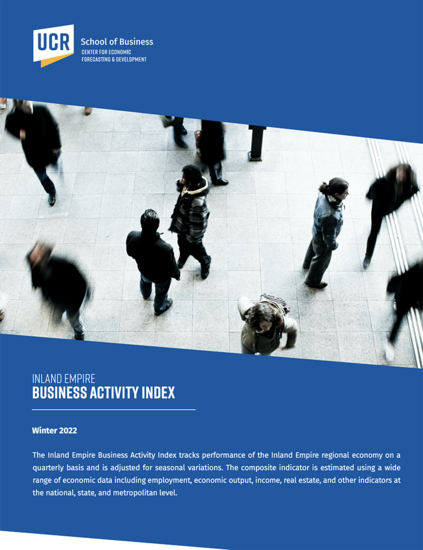
Business activity in the Inland Empire has continued to rise and despite the turbulence in today’s macroeconomy, is forecast to continue its upward climb in the near-term future.

According to the new Inland Empire Business Activity Index released today by the UCR School of Business Center for Economic Forecasting and Development, business activity in the region increased at a 2.8% annualized rate during the 3rd quarter of 2022 (the latest data available) and is forecast to grow between 2% and 3% over the next 12 months. The current increase in the region’s business activity represents a solid jump over growth in the 2nd quarter (1.6%) but a significant decline in growth from previous quarters (4.7% in the 1st quarter and 6.4% in the 4th quarter of 2021).
According to the authors of the analysis, the longer term decline in the IE’s growth rate is to be expected as the region’s economy has transitioned firmly back to pre-pandemic conditions.
“Since the pandemic’s lows, the Inland Empire has experienced a very steady economic recovery, outpacing coastal California along many key measures,” said Taner Osman, research manager at the Center for Economic Forecasting and one of the Index authors. “While we are now seeing some weakness in the residential real estate market, that has been largely offset by impressive growth in employment, the labor force, consumer spending, building permits, and commercial real estate.”
Local commercial real estate construction is indeed experiencing a boom with virtually every non-residential building permit category growing in value in 2022. Surprisingly, given the pandemic-driven shift towards remote work, the category enjoying the largest growth is office property. Building permits for new office space in the Inland Empire surged nearly 380%, pushing the total year-to-date value for new commercial real estate in the region 205.7% above 2021 levels. Moreover, many existing firms have opted to improve or expand their space as illustrated by a 46% annual jump in non-residential alterations and additions.
In terms of vacancy, some segments of the local commercial real estate market are doing better than others. Office properties continue to surprise with vacancies increasing only 0.2 percentage points since the 1st quarter of 2020. Retail property, on the other hand, has exhibited the effects of being disrupted by the rise in e-commerce spending and experienced the largest jump in vacancies (0.6 percentage points). Unsurprisingly, given the escalation in e-commerce, warehouse and distribution property has watched its vacancy rate decline a massive 9.1 percentage points since the 1st quarter of 2020 despite nearly 35 million square feet of new space coming online over the same period.